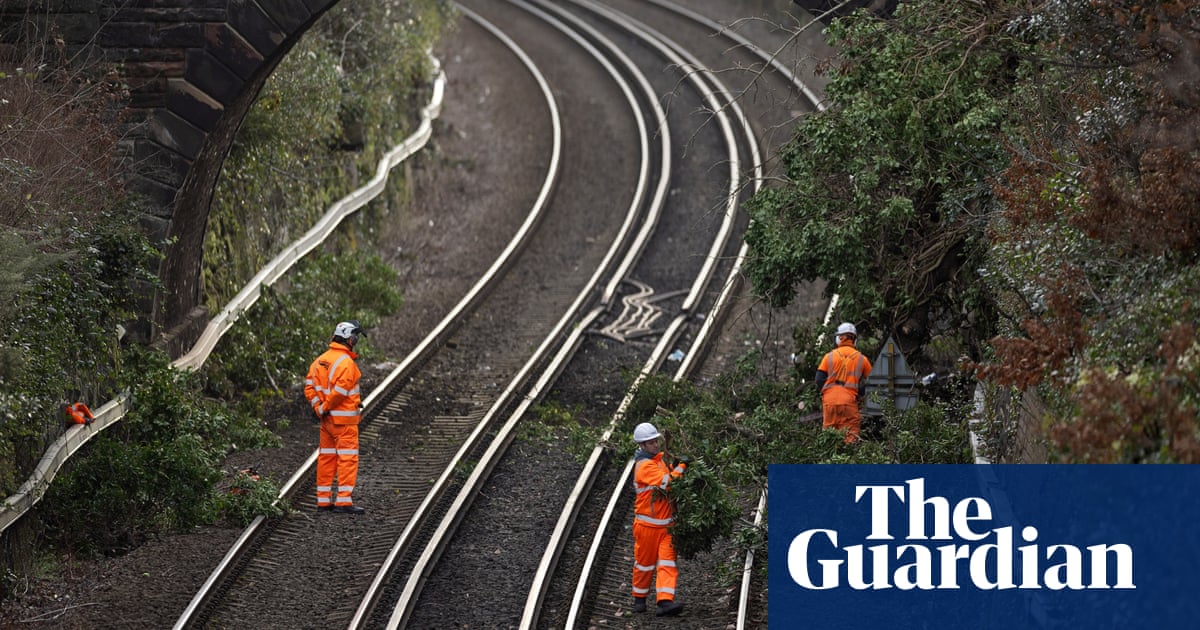Network Rail is to spend nearly £3bn to protect the railway from the effects of the climate crisis and extreme weather, as it warned that the country’s network was having to contend with hotter summers and more winter floods.
As part of its new £45.4bn five-year investment plan, the body in charge of Great Britain’s rail network will spend £2.8bn over the next five years on activities and technology to help it cope with the impact of climate change.
Network Rail said millions would be spent on looking after thousands of miles of drains, cuttings and embankments to make them more resilient to issues such as flooding or landslips.
The taxpayer-funded body plans to send key operational staff to its new “weather academy” to make them “amateur meteorologists”, allowing them to interpret forecasts and make better operational decisions.
The rail network has been battered by extreme weather recently, with more than 14 named storms in the past 12 months, which have led to widespread disruption for passengers.
The most high-profile delays took place over Christmas when severe weather and heavy flooding led to delays and cancellations, including on the Eurostar.
The new investment will also go into building or rebuilding more than 600,000 metres of drains and recruiting more than 400 extra drainage engineers, who will boost the amount of maintenance done of drains so they can handle heavier rainfall.
More than 20,000 cuttings and embankments have been targeted for repair work, with more than 300 miles being strengthened.
The investment marks a major increase from the £1bn that Network Rail had initially earmarked for spending on climate change during the five-year period to April 2029, and is nearly six times the £500m in the investment plan that ran from 2019 to 2024.
The £45bn set aside for the latest investment period, known as control period 7, will be an increase of £3bn on the previous period. However, at current prices and factoring in inflation, it equates to a real-terms cut to £42.8bn, down from £43bn in the previous period.
Martin Frobisher, Network Rail’s group safety and engineering director, told Today on BBC Radio 4: “Climate change is happening right now. It’s affecting the railway with flooding in winter and hotter summers than we’ve ever seen before.”
Andrew Haines, the Network Rail chief executive, said: “We can never completely weatherproof our railway but we can be better prepared and mitigate the worst that Mother Nature throws at us, now and into the future, to keep passengers and services safe and moving.”
Network Rail plans to spend £19.3bn on replacing old assets, as well as investing in other projects such as digital signalling.
after newsletter promotion
It will spend £12.6bn on maintenance, £5.3bn on support functions such as timetabling and IT, £4.4bn on operations such as signalling, and £1.8bn will be put in a “risk fund” to be used for unforeseen events.
About 70% of Network Rail’s funding comes from the taxpayer, with 25% coming from the rail operators to use the lines, and 5% from property income.
The majority of Network Rail’s income – nearly £30bn – will come via grants from the UK and Scottish governments. It will receive £13.8bn in track access charges from train operators and £1.7bn in commercial income, such as from retail and property.
Network Rail has set a number of targets to improve train performance and reduce track failures, including replacing and maintaining 5,000km of track and 3,000 sets of points – the part of the rail that moves, allowing trains to switch tracks.
It has also committed to £4bn of efficiencies in operations and maintenance over the five-year programme, including changing the way it manages external contracts and simplifying its technical standards.







